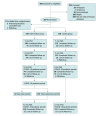Effect of Repeated Low-level Red Light on Myopia Prevention Among Children in China With Premyopia: A Randomized Clinical Trial
- PMID: 37099298
- PMCID: PMC10134010
- DOI: 10.1001/jamanetworkopen.2023.9612
Effect of Repeated Low-level Red Light on Myopia Prevention Among Children in China With Premyopia: A Randomized Clinical Trial
Erratum in
-
Errors in Abstract and Table 3.JAMA Netw Open. 2023 Sep 5;6(9):e2337652. doi: 10.1001/jamanetworkopen.2023.37652. JAMA Netw Open. 2023. PMID: 37768669 Free PMC article. No abstract available.
Abstract
Importance: Myopia is a global concern, but effective prevention measures remain limited. Premyopia is a refractive state in which children are at higher risk of myopia, meriting preventive interventions.
Objective: To assess the efficacy and safety of a repeated low-level red-light (RLRL) intervention in preventing incident myopia among children with premyopia.
Design, setting, and participants: This was a 12-month, parallel-group, school-based randomized clinical trial conducted in 10 primary schools in Shanghai, China. A total of 139 children with premyopia (defined as cycloplegic spherical equivalence refraction [SER] of -0.50 to 0.50 diopter [D] in the more myopic eye and having at least 1 parent with SER ≤-3.00 D) in grades 1 to 4 were enrolled between April 1, 2021, and June 30, 2021; the trial was completed August 31, 2022.
Interventions: Children were randomly assigned to 2 groups after grade stratification. Children in the intervention group received RLRL therapy twice per day, 5 days per week, with each session lasting 3 minutes. The intervention was conducted at school during semesters and at home during winter and summer vacations. Children in the control group continued usual activities.
Main outcomes and measures: The primary outcome was the 12-month incidence rate of myopia (defined as SER ≤-0.50 D). Secondary outcomes included the changes in SER, axial length, vision function, and optical coherence tomography scan results over 12 months. Data from the more myopic eyes were analyzed. Outcomes were analyzed by means of an intention-to-treat method and per-protocol method. The intention-to-treat analysis included participants in both groups at baseline, while the per-protocol analysis included participants in the control group and those in the intervention group who were able to continue the intervention without interruption by the COVID-19 pandemic.
Results: There were 139 children (mean [SD] age, 8.3 [1.1] years; 71 boys [51.1%]) in the intervention group and 139 children (mean [SD] age, 8.3 [1.1] years; 68 boys [48.9%]) in the control group. The 12-month incidence of myopia was 40.8% (49 of 120) in the intervention group and 61.3% (68 of 111) in the control group, a relative 33.4% reduction in incidence. For children in the intervention group who did not have treatment interruption secondary to the COVID-19 pandemic, the incidence was 28.1% (9 of 32), a relative 54.1% reduction in incidence. The RLRL intervention significantly reduced the myopic shifts in terms of axial length and SER compared with the control group (mean [SD] axial length, 0.30 [0.27] mm vs 0.47 [0.25] mm; difference, 0.17 mm [95% CI, 0.11-0.23 mm]; mean [SD] SER, -0.35 [0.54] D vs -0.76 [0.60] D; difference, -0.41 D [95% CI, -0.56 to -0.26 D]). No visual acuity or structural damage was noted on optical coherence tomography scans in the intervention group.
Conclusions and relevance: In this randomized clinical trial, RLRL therapy was a novel and effective intervention for myopia prevention, with good user acceptability and up to 54.1% reduction in incident myopia within 12 months among children with premyopia.
Trial registration: ClinicalTrials.gov Identifier: NCT04825769.
Conflict of interest statement
Figures
References
Publication types
MeSH terms
Associated data
LinkOut - more resources
Full Text Sources
Medical
Miscellaneous



